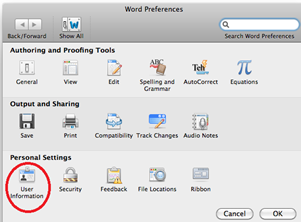However, Word 2011 for Mac does not include an accessibility checking feature. Editor’s note: Later versions of Word for Mac include an accessibility checker (for 2016 and later versions). For more information, see Technique 11 or review how to make your Word documents accessible to people with disabilities. Jul 03, 2014 Click on Word Preference User Information, use the desired name and check the box right below the name that says 'Always use the name regardless of how I'm signed in Office' and that should work. Authors are listed Surname, Initials: “Rathbone, M.A.”. Comma separate multiple authors. Then you put the year of the paper in parens (1994) Then the title of the paper. Not every word is capitalized: “How to format references” Then the journal in Italics “Harvard Educational Review” Then the issue, and the page number. The fix of changing “Author” to your name is incredibly easy as I said. The hard part was finding where that setting was located. But I have done that hard part for you. First, if you have a document that is showing “Author” instead of your name, stop doing any edits! I’m not sure if there is a way to change any edits back from. Open the document. NOTE: If you want to change the author name in a template, right-click on the template, and select Open to open the template. Do not double-click the template to open it as it will only open a document based on the template, not the template itself. Go to File Info.
Creating a Table of Authorities in Word in Office 2011 for Mac is a two-stage process. First, you mark selected text to be indexed; then Word uses the marked text to create the table.
What is a table of authorities? If you’re an attorney, lawyer, paralegal, law student, or some other type of legal beagle, you’ll know that a table of authorities is a list of the references that appear in a legal document. The references can consist of rules, cases, statutes, and so on.

Marking text to include in the table of authorities
Follow these steps to mark text to include in the Table of Authorities:
In Word, choose Insert→Index and Tables.
Select the Table of Authorities tab.
In this tab, you can choose from the following to play around with Preview:
Formats: Lists format styles from which to choose.
Use Passim: If one of the citations is referenced on five or more pages, you can display the word passim instead of displaying the actual page numbers by checking this check box.
Keep Original Formatting: Select or deselect, and observe Preview.
Tab Leader: Choose from the pop-up menu and observe Preview.
Click the Mark Citation button to open the Mark Citation dialog.
The Index and Tables dialog disappears and is replaced by the Mark Citation dialog. When this dialog is open, you can go back and forth between the dialog and the document.
Click the Next Citation button.
Word searches the document for anything that looks like a citation and then selects the likeliest character. If you want to mark the surrounding text as a citation, drag over it in the document to select it; otherwise, click the Next Citation button again to move on.
Click anywhere on the Mark Citation dialog.
Choose a category from the Category pop-up menu.
Click the Mark button to mark the selected text.
Click the Next Citation button to move to the next unmarked possible citation, or click Close to exit the Mark Citation dialog.
While in the Mark Citation dialog, you can click the Category button to display the Edit Category dialog. Here you can change the default category names that appear in the Category pop-up menu.
Building the table of authorities


How Do I Change The Author Name On Word For Mac 2011 Full
After you finish marking the citations, follow these steps to create a Table of Authorities:
How Do I Change The Author Name On Word For Mac 2011 Free
Click in the document to set the insertion cursor at the place where you want the Table of Authorities to appear.
In Word, choose Insert→Index and Tables and click the Table of Authorities tab.
Select Formats, Category, and other options as desired.
Click OK to create the Table of Authorities.